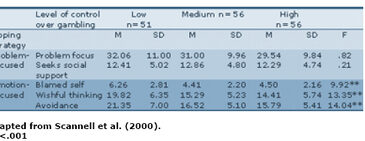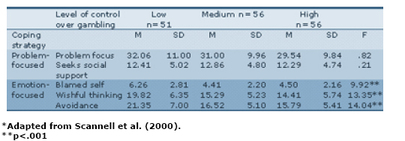According to Scannell, Quirk, Smith, Maddern, and Dickerson (2000), impaired control over gambling might be influenced by certain problem coping strategies. These strategies include problem-focused coping, defined as active problem solving and conflict resolution, and emotion-focused coping, centering on escape or avoidance of a particular problem or conflict (Folkman, Chesney, Pollack, & Coates, 1993, in Scannell et al., 2000). Scannell et al. (2000) studied the association between control over gambling and problem- and emotion-focused coping strategies among a cohort of female poker machine players.
Scannell et al. (2000) recruited 163 women from metropolitan (n=14) and regional (n=6) gaming venues in Australia. Approximately 80% of the research participants reported between one and four years of poker machine play; 40% of the sample played poker machines weekly (Scannell, et al., 2000). Control over gambling (i.e., Low Gambling Control, LGC; Medium Gambling Control, MGC; and High Gambling Control, HGC) was calculated via the Impaired Control Over Gambling Scale (ICOG; Baron & Dickerson, 1994). Coping styles were measured by an adaptation of the Revised Ways of Coping Checklist WCCL-R; Vitaliano, Russo, Carr, Maiuro, & Becker, 1985). The WCCL-R contains two problem-focused coping strategy scales[1] (i.e., Problem Focused and Seek Social Support) and three emotion-focused strategy scales (i.e., Blame Self, Wishful Thinking, and Avoidance).
Data reveal that female control over gambling is not significantly related to age, employment, relationship status, education, and significant life-event stress (Scannell et al., 2000). However, both duration and frequency of poker machine play are significantly related to control over gambling. Additionally, Table 1 shows that “Blamed Self,” “Wishful Thinking,” and “Avoidance” (i.e., emotion-focused) coping strategies generate significant differences between low, medium, and high levels of control over gambling. Indeed, “ . . .there is an inverse relationship between impaired control over gambling and the use of emotion-focused coping strategies” (Scannell et al., p. 428, 2000). Table 1 illustrates this conclusion.
Table 1. Level of control over gambling and coping strategies of female poker machine players*
Scannell et al. (2000) have enhanced our understanding of the relationship between control over gambling and problem- and emotion-focused coping strategies. However, certain research flaws bias their work. For instance, the researchers conclude that female gamblers who predominantly rely on emotion-focused strategies have a lower level of control over gambling than women who rely on problem-focused approaches. This conclusion is not supported by the information reported. The researchers do not provide the relative frequencies of predominant strategies used across gambling control levels. Table 1 shows women with low control over gambling maintain a more diverse set of coping strategies than women with medium and high levels of gambling control.
Additionally, data derive entirely from a sample of Australian female gamblers. As such, we cannot generalize the findings to women in other countries around the world. Furthermore, the research sample is limited to poker machine players. Control over gambling responses might vary across gambling activities; coping strategies also might vary across gambling activities in general and other significant life events. Perhaps most important, the extent to which coping strategies influence disordered gambling is not addressed. Future research should examine the role certain coping strategies play in both preventing and reducing or exacerbating level 2 and 3 gambling disorders.
Nevertheless, Scannell et al. (2000) successfully capture one aspect of gambling behavior from a population segment (i.e., women) that has arguably been largely overlooked by scientists who study gambling.
[1] The response scale for the WCCL-R is as follows: 1=not used, 2=used somewhat, 3=used quite a bit, 4=used a great deal.
References
Baron, E., & Dickerson, M. (1994). Alcohol intake as a variable of impaired control of gambling: a preliminary investigation. The National Association for Gambling Studies, 6, 23-35.
Folkman, S., Chesney, M., Pollack, L., & Coates, T. (1993). Stress, control, coping and depressive mood in human immunodeficiency virus-positive and negative gay men in San Francisco. The Journal of Nervous and Mental Disease, 181, 409-416.
Scannell, E. D., Quirk, M. M., Smith, K., Maddern, R., & Dickerson, M. (2000). Females’ coping styles and control over poker machine gambling. Journal of Gambling Studies, 16(4), 417-432.
Vitaliano, P. P., Russo, J., Carr, J. E., Maiuro, R. D., & Becker, J. (1985). The ways of coping checklist: revision and psychometric properties. Multivariate Behavioral Research, 20, 3-26.
The WAGER is a public education project of the Division on Addictions at Harvard Medical
School. It is funded, in part, by the National Center for Responsible Gaming, the
Massachusetts Department of Public Health, the Addiction Technology Transfer Center of
New England, the Substance Abuse and Mental Health Services Administration, and the
Center for Substance Abuse Treatment.





